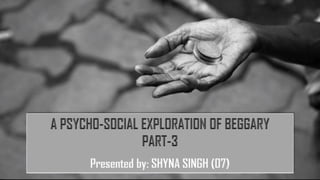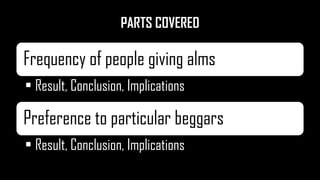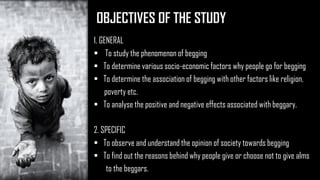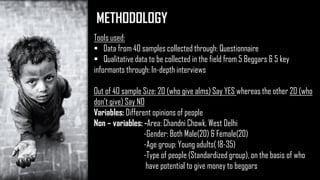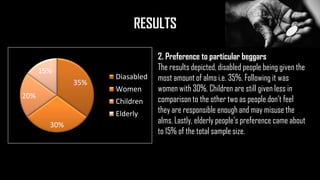Beggary in Delhi
- 2. PARTS COVERED Frequency of people giving alms • Result, Conclusion, Implications Preference to particular beggars • Result, Conclusion, Implications
- 4. 1. GENERAL ▪ To study the phenomenon of begging ▪ To determine various socio-economic factors why people go for begging ▪ To determine the association of begging with other factors like religion, poverty etc. ▪ To analyse the positive and negative effects associated with beggary. 2. SPECIFIC ▪ To observe and understand the opinion of society towards begging ▪ To find out the reasons behind why people give or choose not to give alms to the beggars.
- 5. Tools used: ▪ Data from 40 samples collected through: Questionnaire ▪ Qualitative data to be collected in the field from 5 Beggars & 5 key informants through: In-depth interviews Out of 40 sample Size: 20 (who give alms) Say YES whereas the other 20 (who don’t give) Say NO Variables: Different opinions of people Non – variables: -Area: Chandni Chowk, West Delhi -Gender: Both Male(20) & Female(20) -Age group: Young adults( 18-35) -Type of people (Standardized group), on the basis of who have potential to give money to beggars
- 6. DIMENSIONS OF BEGGARY IN JAMMU AND KASHMIR- AN EMPIRICAL STUDY (Neha Tomar Dr. Saroj Choudhary, 2016) Findings of the study: ▪ The respondents were asked as to whom do they generally prefer to give alms and their response depicted that majority of respondents preferred giving alms to beggars who are handicapped, followed by who are in old age. Only a decent amount of respondents preferred giving alms to child beggars. There was also diversion between different genders. ▪ Upon how often people in general like to give alms to beggars, the response of the majority of the respondents was in the affirmative, while a miniscule amount of respondents said sometimes they give and sometimes they don’t.
- 7. 1. Frequency of people giving alms It can be seen that half the respondents rarely give alms to beggars which again points towards the trust issues that people have. The above point makes the premise even more concrete as there is 17.5% of the population which never gives alms to beggars Only 5% of the respondents give alms very often. The rest of the sample size gives alms sometimes. 50% 17% 28% 5% Very often Sometimes Rarely 4th Qtr
- 8. 2. Preference to particular beggars The results depicted, disabled people being given the most amount of alms i.e. 35%. Following it was women with 30%. Children are still given less in comparison to the other two as people don’t feel they are responsible enough and may misuse the alms. Lastly, elderly people’s preference came about to 15% of the total sample size. 35% 30% 20% 15% Diasabled Women Children Elderly
- 9. Through our research, we inferred that: • Majority of respondents give alms to beggars very often.. . • Most preference is given to disabled beggars which ordinarily sounds good but in the process the practice of begging gets encouraged. • The data, thereby proves that, the major reasons for giving alms range from feeling pity to doing charity, good deeds, sympathy etc.
- 10. 1. • Steps both at ground level and policy level have to be taken for upliftment of these people for a better tomorrow. 2. • Identifying the true needs of these people and inculcating them into institutions like NGO’S and fruitful schemes to get them out of streets and live a life of dignity 3. • Abolishing of begging as a business so as to curb the ways of easy money and improve the overall condition of this strata.
